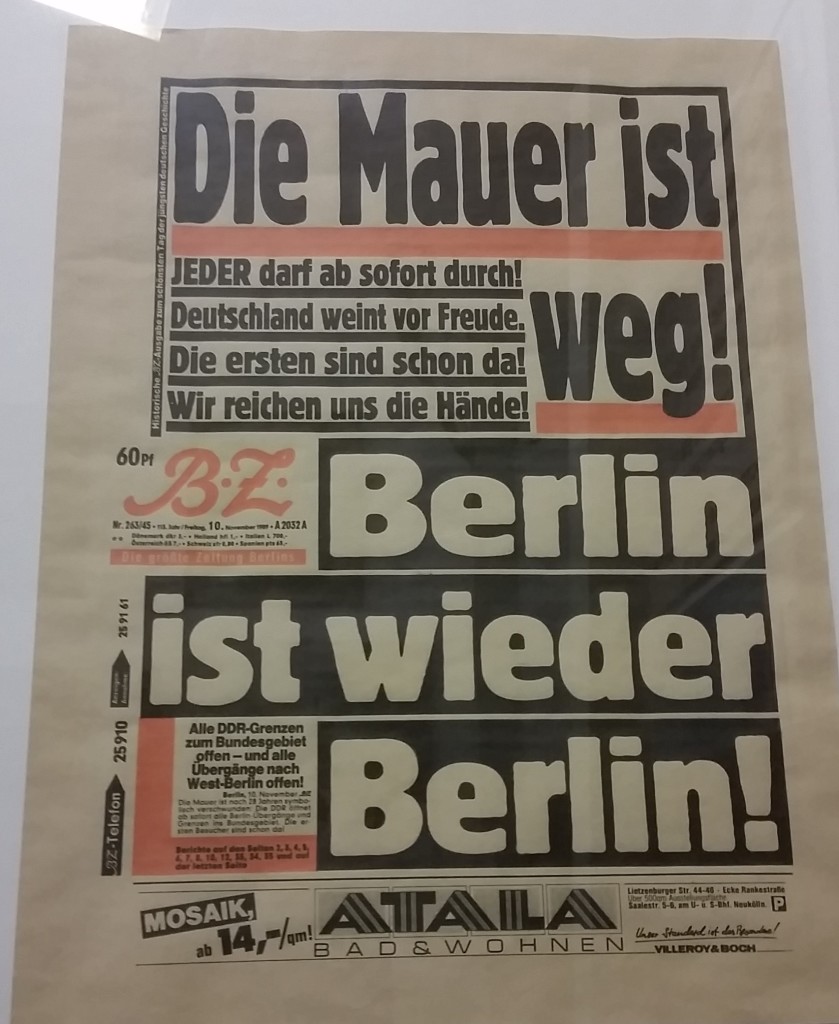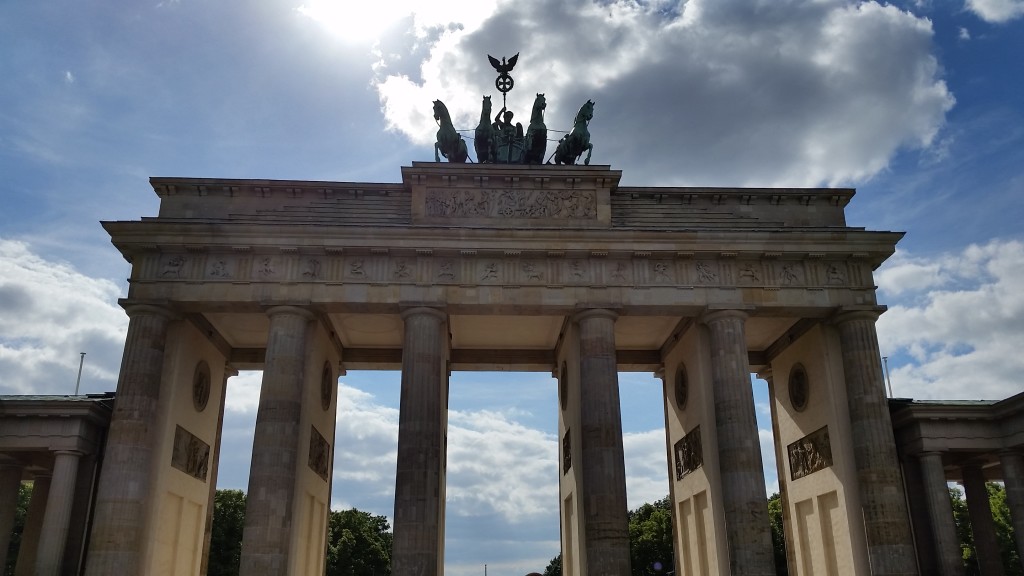As we headed back into Berlin, we were reminded of the special treachery that is driving in this crazy capitol with extremely risk-friendly bicyclists who eschew helmets in the name of freedom. I have to give my husband major props for bravely navigating the madness without incident. My man of steel (nerves)!
At the condo we showered, regrouped, then headed out to the Spy Museum, Joe’s pick for Berlin. From my list of must-sees everyone picked a priority; we hit everything on the list but two items. I’m proud of my planning, but I wish I’d added a full day to our time in Berlin; I hate to leave stuff on the table when circling back can literally take years.
The Spy Museum had kitschy spots, but it covered the history of the Stasi (State Police) in East Germany well. It was nice to see evidence that it wasn’t just my imagination–that Cold War shit was real, and crossing into the DDR was like a spy movie. Exhibit A:
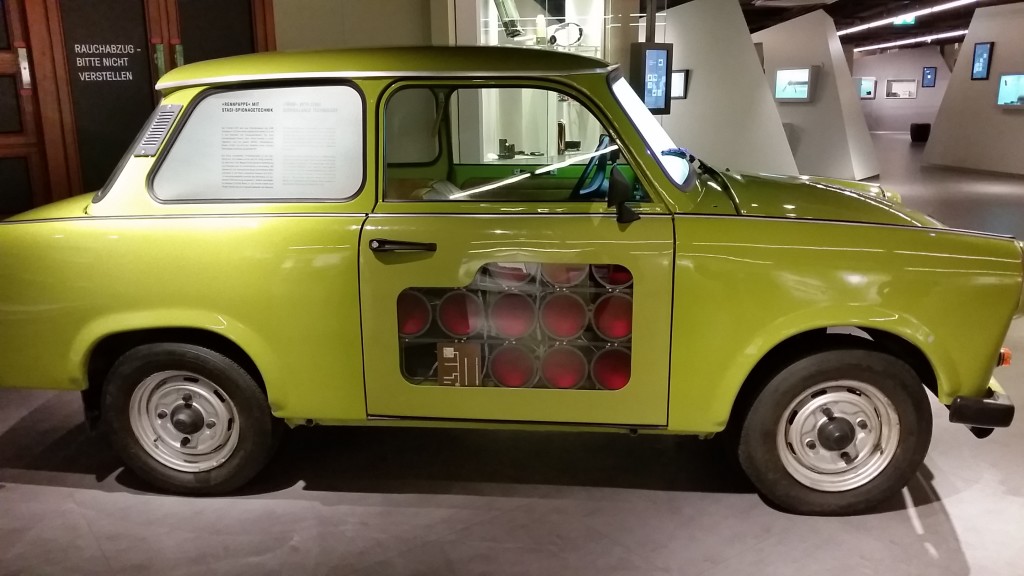
An actual Trabbi (the East German excuse for a car)…hard to believe people waited 20 years for such a junker. This one was a Stasi (the brutal State Police) vehicle, complete with licensing devices hidden in the door. Because communism is paranoid. Well, anything that goes against basic human rights usually is. Exhibit B: The current US administration.
The museum also has a cool exhibit on the Enigma decoder that Alan Turing used, and even a mention of the Zodiac Killer. The James Bond exhibit is severely cheesy, but then, all the spy tools from the 1930s-1980s were actually pretty funky. Given today’s high-tech spy gadgets we all willingly carry in our pockets, exposing our whereabouts and inner thoughts to anyone with a computer, those fountain pens and bowties with cameras in them, and microphones hidden in lamps (de rigeur in any Soviet hotel), seem pretty cartoonish. But they were cutting edge back in the day.
Lots to see, no wimps allowed.
After the museum we joined dear friends for dinner. They took us to the most amazing Indian restaurant (Madras) with the mulligatawny soup I will spend the rest of my life trying to replicate. Scott sent me his recipe; I have high hopes.
The next day was Go Time: Lots to see, no wimps allowed. We started at the Wall Museum at Checkpoint Charlie. When I had last visited, it was tiny. I remember an actual Trabbi with a dummy stuffed in the trunk to show how people smuggled themselves out of the DDR. Historic photos, actual border signs from the late ’60s/early ’70s. That was about it.
Oh my, how that museum had grown. It really helped that after the Wall came down all those Stasi files and more brave attempts and successes were now disclosed. A lot more cars with people stowed away in the seats and side panels, boats used to cross the shallow Baltic, and home-made hot air balloons. Incredible stories, but all true. And of course there was the story of the borders opening a crack, then swung wide. The Wall hammered to bits by jubilant Germans, and then the official dismantling, all those new laws and social shifts. It’s a lot to cover, but it’s largely devoted to the story of the 3 million people who escaped the DDR. So many amazing rescues and brave Fluchthelfer (escsape helpers). It was quite moving. Think of all the petty things we complain about everyday…and how people risked their lives to get what we have.
The best part for me was the section devoted to the end of East Germany. I remember standing in my friend’s living room in Boulder, Colorado, on Nov. 9, 1989, watching the news with tears streaming down our faces. No one I knew ever thought that would happen in our lifetime and yet we were watching crazy happy Germans partying on top of the Wall, no machine gun fire at all. As Katy had told my girls in Wampen: “That day the world actually got better.”
Outside the museum, the curators let the world know how the struggle for freedom and peace was faring with this timely message. Given Putin’s style, I fear it will hang there for a while, but I truly appreciate the effort:
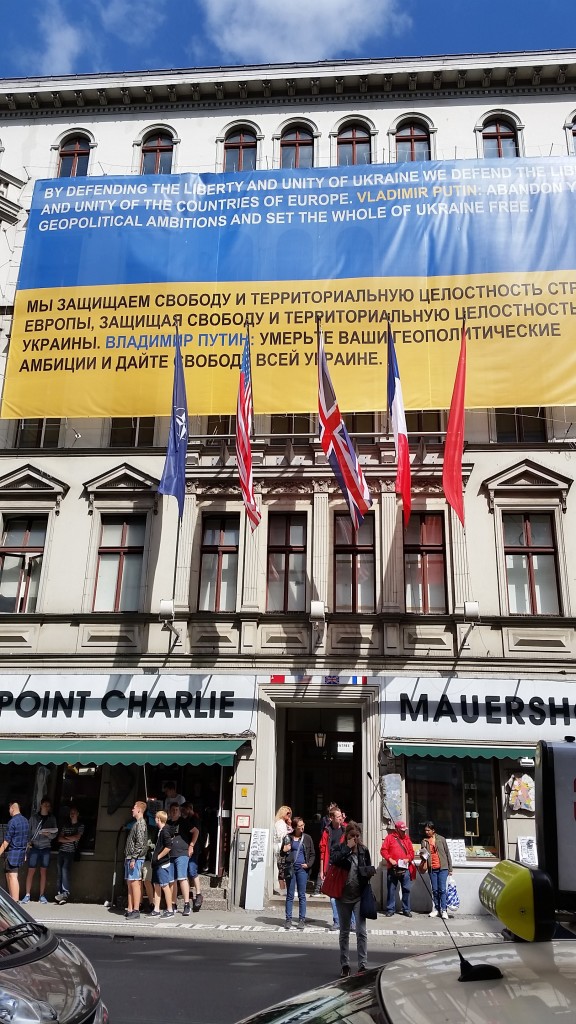
A message for Putin on the Wall Museum. Egomaniacs, you are standing on our last nerve. Oppress the people and it will not end well for you. Just ask Erich Honecker.
After a much-needed coffee, we took the Ubahn to the Brandenburger Tor, which had straddled the Wall all those years. I can’t explain how great it felt to walk right through it. The atmosphere was a light and happy one, much different from my somber first time there. Even the sun put on a great show:
We walked through the gate to view the Reichtstag Building, which is quite impressive.
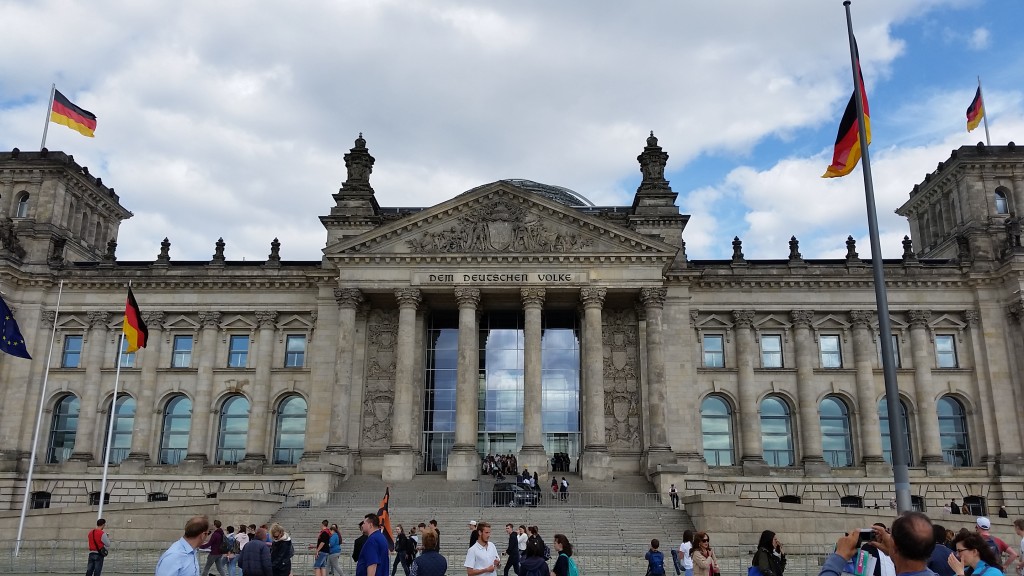
Dem Deutschen Volke! This is where the Bundestag, the current German parliament, now meets. Note the clouds reflected in the windows. Der Himmel uber Berlin, nah?
We paid respects at the memorial to the Roma and the Sinti, which was a placid pond surrounded by panels of glass telling the story of these 500,00o who were abused and murdered by the Nazi regime.
Next we walked to the Memorial for the Murdered Jews of Europe. Maybe you’ve seen stories of how people have disrespected this monument. Of course nothing could do justice to the victims of the Holocaust–any attempt is going to fall short–but I feel this memorial fails in many significant ways. First, it is set close to a very busy intersection, so it’s not quiet enough to begin with. Additionally, because it’s such a busy corner and because there
The walls rise around you, perhaps to symbolize the way evil rose up around the victims.
is no fence or meaningful border around it, and no sign that I saw as we approached, you can stumble upon it and not realize you’re at a memorial. It’s a grid of thousands of massive rectangular concrete stones of the same size but varying heights. The shorter stones are around the edges, so as you walk in between them deeper into the center, the walls rise around you, perhaps to symbolize the way evil rose up around the victims. You can glimpse the paths between the stones, but that’s part of the deception–you think you know what’s next, but the ground dips and rises in the middle in subtle slopes that give the impression of rising (false hope), only to sink lower. So maybe it reflects the confusion of hope that may have glimmered and baffled the victims as they struggled to stay afloat in such a cruel and unpredictable reality. Or at least, that’s what I had to come up with on my own, because there is really no guidance at all in what you are experiencing and what it means. Memorial visitors don’t need to be bonked on the head, but with no written or labeled context, a memorial becomes generic, and therefore is no memorial. There seemed to be another part to it, an underground exhibit of sorts, which we stumbled on purely by accident, so there’s something wrong there.
I will say it succeeded in being disorienting in a labyrinth-like way. But what I found really disheartening was the lack of reverence from many of the people walking it. Some people allowed their kids to actually run through the stones. But the worst were the people around the edges, who were sitting on the stones as if they were park benches. The Jewish photographer Shahak Shapira had already commented on this with his photoshopped solution to other horrible behavior, so I guess I naively thought word had gotten around. But the security personnel that patrol it had to frequently remind people they were at a memorial and to please be respectful, shooing them off the stones. I think setting the memorial back from the sidewalk with more green space around it to allow for quiet, and maybe a low fence and significant signage could have served the cause better. There’s no excuse for people behaving like that, but you have to wonder if they even knew they were at a memorial. It really disturbed me that there was no visible reference to what this memorial is actually about. Like the murder of a people for their religion. Kind of central to the story. And if we don’t tell the stories….
I’m not the only one who has had such a reaction. In fact, I found this harsh but pretty accurate critique while looking for pictures online to check my memory of the space. My searching confirmed that nope, there is no fence around it, and the only evidence of signage I found was the sign outside the underground exhibit. So it wasn’t that we didn’t notice a sign where we entered the space; there wasn’t one.
We walked miles and miles that day, and ended the night with dinner in a quiet Italian restaurant on a wide, mostly dead street (pockets of the east side of town are still struggling for that economic miracle, evidently). The next day I met with another friend, then it was off to Wiedenbrück to see my German “mom.” I hated to say goodbye to Berlin. It still has a sassy graffiti habit I admire–the need for self-expression through spray paint had sunk into its colorful soul, evidently. But, thankfully, it had shed that most oppressive concrete overcoat.
Next up: Planet Wiedenbrück

